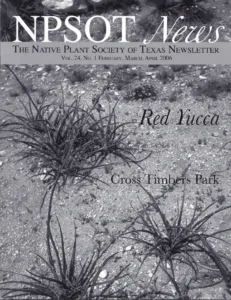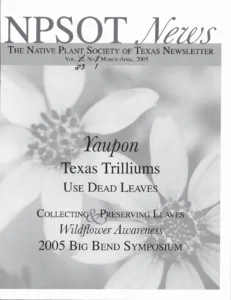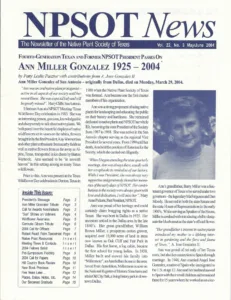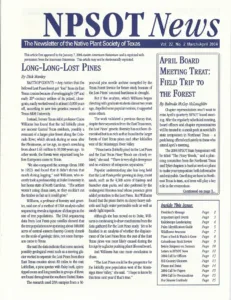Latest Issues

Winter 2024 Member Magazine
From Pines to Petals: Exploring the Pineywoods | 2023 Society Award Recipients | No-Freeze Trees | Water-Wise Strategies | Conservation Champions | Power Plants for Pollinators | Using the Invasive Plant Database | Coming Soon: More Native Milkweed! | Native Gardens are For the Birds | Native Plants Thriving in Town Hall | Promoting Native Milkweeds | Engaging the Next Generation | Native Plant Student Art Showcased | If You Know What to Look For

Fall 2023 Member Magazine
Texas really IS like a whole ‘nother country. Its sheer size, variety of terrain, and biological diversity is staggering. The great Lone Star state contains barrier islands and coastal lowlands, large river floodplain forests, rolling plains and plateaus, forested hills, deserts, and a wide variety of aquatic habitats.

Summer 2023 Member Magazine
Our mission is to promote the conservation, research, and utilization of the native plants and plant habitats of Texas through education, outreach, and example.
Distribution
- Texas Native Plants is published quarterly and the digital version is distributed free to all Society members in current standing.
- The digital version is also available in our library below.
- Print versions are mailed at no cost to Society members in current standing who select to receive a print copy when they join/renew.
- Libraries, educational institutions and other organizations may qualify to receive the publication for a $5 annual fee.
- Contact the membership coordinator.
- Many of our chapters publish their own newsletters and websites.
- These have their own deadlines and guidelines. See list of chapters.
History
Since its founding the Society has provided a news periodical to its members. there have been a variety of names and formats. The Texas Wildfower Newsletter edited by Carroll Abbott served as the first newsletter. He advocated the formation of the Native Plant Society of Texas in his quarterly publication Texas Wildflower Newsletter. After the Society was created in 1980, a free subscription to Abbott’s newsletter was provided as a benefit to all members. His declining health eventually prompted Abbott to request that the Society start its own newsletter. Lean more about the Carroll Abbott story.
Beginning in 1983 our own official publication has documented the evolution of the native plant movement and the Native Plant Society of Texas. The publication has had several slightly different names and formats over the years. By 2005 it had evolved into a full-color glossy magazine.
Editorial Submissions
The Native Plant Society of Texas encourages submission of articles, photos, pertinent news or other interesting information for publication.
- Submit articles or written items as email attachments.
- Send photos as email attachments in JPG, RAW or TIFF format.
- Larger file size and best quality are preferable.
- Contact the Editor for more information.
We reserve the right to edit all submissions for accuracy, relevance, length, grammar or for other reason. In matters of style our print publication generally follows the Chicago Manual of Style.
Unless prior arrangements with the editor are made, submissions may also appear on our website and linked on our social media pages. We do not accept outside advertising in any of our publications.
Publications Library
Click below to view issues by year/editor. Or visit our online archive.
2008 – Spring
- The Rimrock Ridge Story
- Rainwater harvesting
2008 – Winter
- What does it mean to be Native
- Low-maintenance landscapes
- Compass plant
2007 – Fall
- How a Purple Thistle Taught Children Ecology
- San Pedro Springs
2007 – Spring
- Plant Identification for Dummies … Err, Non-Botanists
- Who’s Watching the Water
2007 – Winter
- Silveus’ Dropseed Prairies
- Reclaiming the Garden of Eden
2006 – Fall
- Stone in the landscape
- Native persimmons
2006 – Spring
- Red Yucca
- The Cross Timbers that used to be
2006 – Winter
- Mistletoe
- A new home for the Society
2005 – Fall
- Wildscapes and the Society Mission
- Common Landscape Mistakes
2005 – Summer
- Matt Turner on Sotol
- Host plants for butterflies
2005 – Spring
- Texas trilliums
- Cut-leaf daisy
- Yaupon holly
2004 – Nov/Dec
- Saw-leaf daisy
- Creating a Small Habitat Will Attract Birds
2004 – Sept/Oct
- Agalinis homalantha
- Clematis drummondii
2004 – Jul/Aug
- Silverleaf nightshade
- Passiflora of Texas
2004 – May/June
- American basketflower
- Living on a gold mine — five years later
2004 – March/April
- Benny Simpson on Sumacs
- Claytonia virginica
2004 – Jan/Feb
- A NICE! idea in Boerne
- Greenbrier
- 2003 Symposium review




















